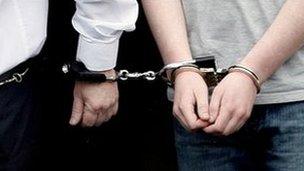Youth and child crime rates fall in Wales, YOT figures show
- Published

Neath Port Talbot has seen a fall in young offenders from 519 in 2010-11 to 209 in 2011-12
The number of children in Wales getting caught up in crime is continuing to fall, figures show.
In the last decade annual reported youth crime in Swansea alone has fallen from 2,044 incidents to 428 last year.
And over the last two years Welsh youth offending teams (YOTs) have seen a fall in the number of children aged 10-17 being dealt with by the service.
The decline is attributed to targeting children likely to get into trouble such as those starting to play truant.
Swansea Youth Offending Service is regarded as one of the leaders in the field using a restorative justice system that is being followed by others.
Its report, external to the city and county council said the reduction in youth crime between 2001-2 and 2011-12 has "an annual saving to the public purse of over £2.8m in Swansea alone."
"Prevention and early intervention strategies that reinforce the responsibilities of parents for their children and their behaviour have been at the centre of this shift in levels of youth crime and anti-social behaviour," it added.
In Swansea, police and social services, together with health and council staff, decide whether it is more appropriate for a young offender to go through the court system and end up with a criminal record or whether they could benefit from a "second chance".
This means they still face a punishment but it is more about making amends and they do not receive a criminal record.
Their victim is also involved and the offender receives on-going assessments and support if necessary to try to stop any repeat offending.
"It gives young people a route to make amends and have a second chance," said Dusty Kennedy, head of the Youth Justice Board Cymru (YJB).
He explained the system is double-edged, identifying areas or young people likely to start getting into trouble and taking preventive action as well as working with young offenders to prevent further offending.
He highlighted Gwynedd and Anglesey YOT as reducing offending several years ago by working with police and going into schools to educate children against anti social behaviour.
And he said Swansea YOT had seen a big fall in repeat offenders - decreasing from 204 to 23 between 2001 and 2012 - due to the implementation of a "golden fortnight", when young people who have caused minor offences are assessed and their parents involved to try to change the child's behaviour.
The biggest decrease in offending in the last two years has been in Neath Port Talbot.
It has seen a fall in young offenders from 519 in 2010-11 to 209 in 2011-12, according to figures, external released by the Youth Justice Board.
Mr Kennedy, whose work involves monitoring and helping improve the effectiveness of YOTs in Wales, said the model in Neath Port Talbot was being evaluated to see if other groups could benefit although it had been based on the work of the Swansea YOT.
Gwynedd and Anglesey saw the smallest decrease in children offending from 441 to 416 over the last two years, although its YOT is said to have seen a bigger fall in previous years due to implementing prevention work earlier.
Latest information for Cardiff is not available due to technical problems reporting the data.
So although overall figures for Wales show 2,770 fewer young people involved in crime in 2011-12 - down to 7,408 compared with 10,181 in 2010-11 - these figures do not provide a true reflection of the actual number of offenders.
- Published3 December 2012
- Published28 March 2011